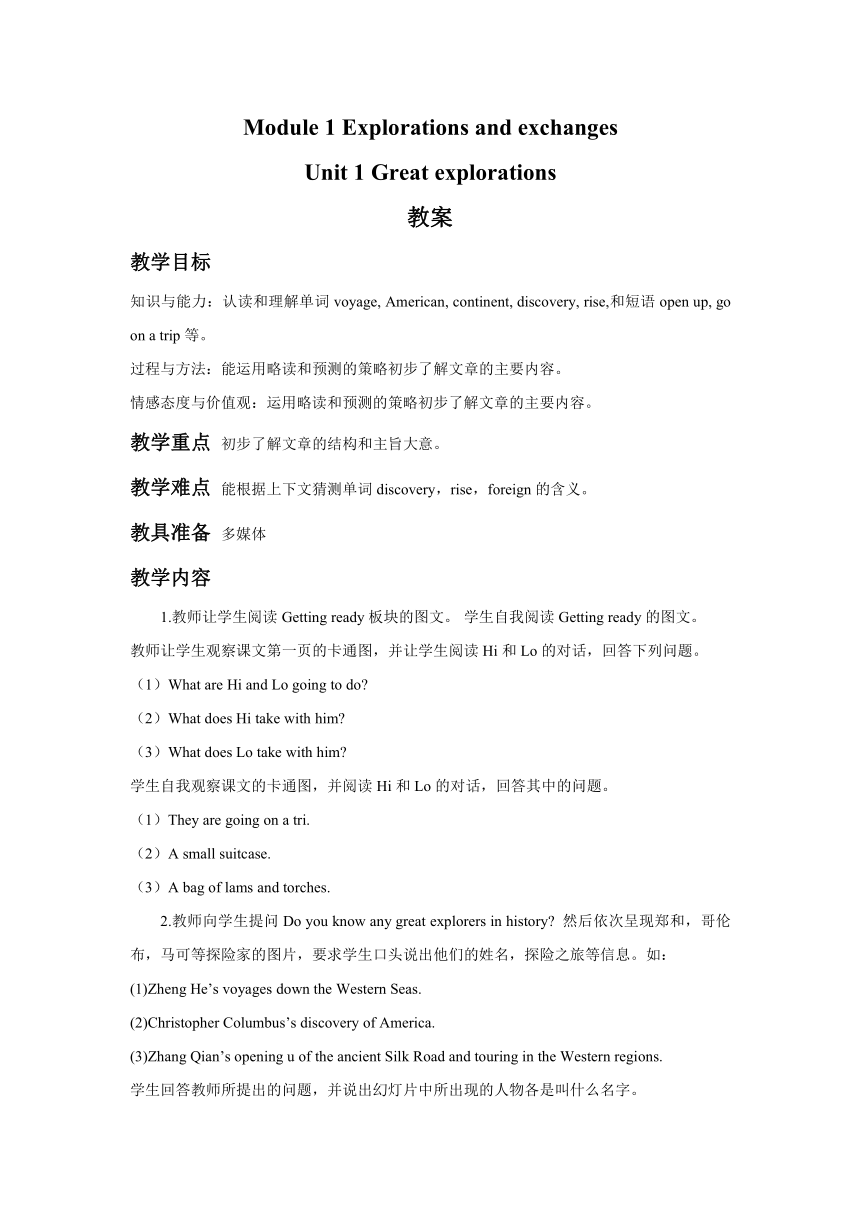广东省深圳市Module 1 Unit 1 Great explorations 教案(1)
文档属性
| 名称 | 广东省深圳市Module 1 Unit 1 Great explorations 教案(1) |

|
|
| 格式 | zip | ||
| 文件大小 | 119.3KB | ||
| 资源类型 | 教案 | ||
| 版本资源 | 牛津深圳版 | ||
| 科目 | 英语 | ||
| 更新时间 | 2017-08-09 18:06:33 | ||
图片预览

文档简介
Module
1
Explorations
and
exchanges
Unit
1
Great
explorations
教案
教学目标
知识与能力:认读和理解单词voyage,
American,
continent,
discovery,
rise,和短语open
up,
go
on
a
trip等。
过程与方法:能运用略读和预测的策略初步了解文章的主要内容。
情感态度与价值观:运用略读和预测的策略初步了解文章的主要内容。
教学重点
初步了解文章的结构和主旨大意。
教学难点
能根据上下文猜测单词discovery,rise,foreign的含义。
教具准备
多媒体
教学内容
1.教师让学生阅读Getting
ready板块的图文。
学生自我阅读Getting
ready的图文。
教师让学生观察课文第一页的卡通图,并让学生阅读Hi和Lo的对话,回答下列问题。
(1)What
are
Hi
and
Lo
going
to
do
(2)What
does
Hi
take
with
him
(3)What
does
Lo
take
with
him
学生自我观察课文的卡通图,并阅读Hi和Lo的对话,回答其中的问题。
(1)They
are
going
on
a
tri.
(2)A
small
suitcase.
(3)A
bag
of
lams
and
torches.
2.教师向学生提问Do
you
know
any
great
explorers
in
history
然后依次呈现郑和,哥伦布,马可等探险家的图片,要求学生口头说出他们的姓名,探险之旅等信息。如:
(1)Zheng
He’s
voyages
down
the
Western
Seas.
(2)Christopher
Columbus’s
discovery
of
America.
(3)Zhang
Qian’s
opening
u
of
the
ancient
Silk
Road
and
touring
in
the
Western
regions.
学生回答教师所提出的问题,并说出幻灯片中所出现的人物各是叫什么名字。
教师授课过程(教师活动)
学生学习过程(学生活动)
3.教师让开展“头脑风暴”,说说其他著名的探险家及其探险之旅。如:
(1)Captain
Cook’s
discovery
of
Australia
(2)Monk
Xuanzang
’s
journey
to
the
West.
(3)Ferdinand
Magellan’s
global
voyage.
学生根据教师所开展的“头脑风暴”,说出其中的著名探险家和他们的探险之旅。
4.教师让学生完成What
do
you
know
about…
部分的练习。并让学生认读和理解单词voyage,American,continent和短语open
up,go
on
a
trip等。
5.学生完成课文的练习,并认读和理解其中所出现的单词和短语。
教师让学生观察文章的插图并阅读标题,预测文章的主要内容,教师以“蜘蛛网”形式呈现给学生预测。(具体“蜘蛛网”形式见黑板)
利用观察并阅读的形式,完成蜘蛛网,从而了解文章的主要内容。
教师让学生完成Before
you
read部分的练习。并让学生认读和理解单词tread和短语set
up.
教师让学生完成Work
out
the
rule部分的内容,然后阅读Things
to
remember部分的内容。
6.教师呈现下列内容,要求学生用such或so填空
(1)This
is___
a
difficult
Math’s
problem
that
nobody
in
my
class
can
work
it
out.
(2)
My
sister’s
hair
is
___
long
that
it
touches
her
waist.
(3)He
is
___
strong
that
he
can
lift
the
heavy
box
alone.
(4)I
live
in
___
a
noisy
flat
that
I
cannot
sleep
at
night.
学生完成课文练习,并认读教师所提示的单词和短语
作业布置
1.找出主阅读篇章中含有结果状语从句的句子,然后用too
…
to或enough
to结构改写。
2.
完成第九页练习C1,C2。
1
Explorations
and
exchanges
Unit
1
Great
explorations
教案
教学目标
知识与能力:认读和理解单词voyage,
American,
continent,
discovery,
rise,和短语open
up,
go
on
a
trip等。
过程与方法:能运用略读和预测的策略初步了解文章的主要内容。
情感态度与价值观:运用略读和预测的策略初步了解文章的主要内容。
教学重点
初步了解文章的结构和主旨大意。
教学难点
能根据上下文猜测单词discovery,rise,foreign的含义。
教具准备
多媒体
教学内容
1.教师让学生阅读Getting
ready板块的图文。
学生自我阅读Getting
ready的图文。
教师让学生观察课文第一页的卡通图,并让学生阅读Hi和Lo的对话,回答下列问题。
(1)What
are
Hi
and
Lo
going
to
do
(2)What
does
Hi
take
with
him
(3)What
does
Lo
take
with
him
学生自我观察课文的卡通图,并阅读Hi和Lo的对话,回答其中的问题。
(1)They
are
going
on
a
tri.
(2)A
small
suitcase.
(3)A
bag
of
lams
and
torches.
2.教师向学生提问Do
you
know
any
great
explorers
in
history
然后依次呈现郑和,哥伦布,马可等探险家的图片,要求学生口头说出他们的姓名,探险之旅等信息。如:
(1)Zheng
He’s
voyages
down
the
Western
Seas.
(2)Christopher
Columbus’s
discovery
of
America.
(3)Zhang
Qian’s
opening
u
of
the
ancient
Silk
Road
and
touring
in
the
Western
regions.
学生回答教师所提出的问题,并说出幻灯片中所出现的人物各是叫什么名字。
教师授课过程(教师活动)
学生学习过程(学生活动)
3.教师让开展“头脑风暴”,说说其他著名的探险家及其探险之旅。如:
(1)Captain
Cook’s
discovery
of
Australia
(2)Monk
Xuanzang
’s
journey
to
the
West.
(3)Ferdinand
Magellan’s
global
voyage.
学生根据教师所开展的“头脑风暴”,说出其中的著名探险家和他们的探险之旅。
4.教师让学生完成What
do
you
know
about…
部分的练习。并让学生认读和理解单词voyage,American,continent和短语open
up,go
on
a
trip等。
5.学生完成课文的练习,并认读和理解其中所出现的单词和短语。
教师让学生观察文章的插图并阅读标题,预测文章的主要内容,教师以“蜘蛛网”形式呈现给学生预测。(具体“蜘蛛网”形式见黑板)
利用观察并阅读的形式,完成蜘蛛网,从而了解文章的主要内容。
教师让学生完成Before
you
read部分的练习。并让学生认读和理解单词tread和短语set
up.
教师让学生完成Work
out
the
rule部分的内容,然后阅读Things
to
remember部分的内容。
6.教师呈现下列内容,要求学生用such或so填空
(1)This
is___
a
difficult
Math’s
problem
that
nobody
in
my
class
can
work
it
out.
(2)
My
sister’s
hair
is
___
long
that
it
touches
her
waist.
(3)He
is
___
strong
that
he
can
lift
the
heavy
box
alone.
(4)I
live
in
___
a
noisy
flat
that
I
cannot
sleep
at
night.
学生完成课文练习,并认读教师所提示的单词和短语
作业布置
1.找出主阅读篇章中含有结果状语从句的句子,然后用too
…
to或enough
to结构改写。
2.
完成第九页练习C1,C2。
